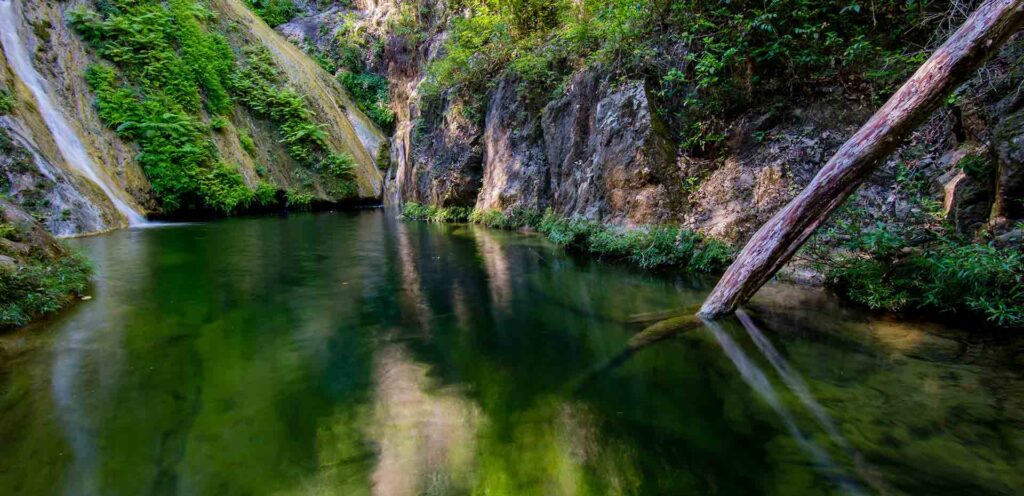14 Natural treasures to visit in Cuba


The largest country in the Caribbean is home to great natural treasures distributed throughout its territory, with around 20 percent managed under some form of environmental protection. From east to west, along the main island, in the hundreds of keys that define it as an archipelago and the surrounding seas, boast wonderful landscapes, spectacular varieties of flora and fauna with high levels of endemism.
Making a selection is always difficult, but below you will find the most attractive and accessible natural treasures from a general perspective, where you can experience multiple activities to interact with the green surroundings and its inevitable combination with the sea: ecological and thematic trails, walks horseback riding, cycling, bird watching, exploring caves, climbing, diving, among others, to return to our daily lives energized and full of fresh air.
Valle de Viñales,Pinar del Río

Declared a Natural Landscape of Humanity, it combines extensive green plains and fields, with cave systems and multiple picturesque elevations, called mogotes, in a spectacle worthy of the most beautiful oil painting, and supported by a colorful urbanization that brings together a large number of private accommodations. .
Where to stay in Viñales: best areas and hotels
Centro de Viñales

The surroundings of Viñales are an interesting area to stay, in addition there are several hotels that have a swimming pool and magnificent views of the Viñales Valley. Our favorite accommodation in this area and, due to its proximity to the center of Viñales, is the Hotel Horizontes La Ermita, a hotel that has all the facilities for tourists and with great views of the Viñales Valley.
There are also some private houses to stay, if you want tranquility, this is the best area, although remember that to move you must do it with transport. Best accommodations around Viñales:
- Hotel Horizontes Los Jazmines
- Hotel Horizontes La Ermita
- Horizontes Villa Rancho San Vicente
- Recommended private houses:Belkys and Omar Cabin
Ciénaga de Zapata (Matanzas)

Largest wetland in the insular Caribbean, categorized as a Ramsar site. It has the largest reservoir of migratory and endemic birds in Cuba, such as the tocororo and the ferminia, and a crocodile farm essential for the preservation of the species.
Where to Stay?
Located in the Ciénaga de Zapata, province of Matanzas, bathed by the waters of the Caribbean Sea, this hotel rises where the visitor has all the facilities to enjoy the beach and nature. With an All Inclusive modality, its attractions include the practice of bird watching and contemplative diving, as it has 2 International Diving Centers.
The Hotel Villa Playa Giron offers air conditioning. The hotel is suitable for sports. There is a bar inside the hotel. The property is fully equipped with a conference room. Guests can use the hotel restaurant. The Hotel Villa Playa Giron has facilities for business tourism. The hotel is ideal for sports.
Parque Nacional Alejandro de Humboldt, Holguín y Guantánamo

It is the largest and most important biosphere reserve on the island, and has been declared a World Heritage Site. Mountain, coastal and river ecosystems coexist in it. Two percent of the universal flora is represented there and rare animals such as the almiquí live there. It was the last place in Cuba where the royal carpenter was seen.
The park offers camping places, lodging, guided routes and highly trained personnel to solve any doubt or problem for visitors. You can do the trails Sendero Marino por Bahía de Taco, Sendero el Balcón de Iberia, Sendero el Recreo, Sendero el Copal and Sendero Riberas del Jiguaní, where you will come into direct contact with nature, exploring both river and land space. You will enjoy spectacular views, refreshing waters, beautiful landscapes of endemic vegetation, interesting fruit crops and being lucky enough to appreciate exotic animals in their natural environment.
Jardines de la Reina, Ciego de Ávila y Camagüey

An almost virgin archipelago in the south of Cuba, made up of more than 600 immensely rich cays and a model of sustainable exploitation. More than one hundred species of fish of economic and contemplative importance, crustaceans, turtles and corals, allow controlled sport fishing and diving, from floating hostels.
When we first see the island landscape, currently the most preserved in the Caribbean, we understand what inspired Columbus to name it that way. It is a pristine environment, without buildings, avenues or smoke. This area maintains practically the same state as when the Spanish navigators crossed its waters.
How to get to the Jardines de la Reina
To get to Jardines de la Reina it is necessary to book on one of the “live on board” cruises that depart from the port of Júcaro; connecting flights may be necessary. The floating platform known as La Tortuga is the visitor reception point, the diving center and an eight-room hotel. This, together with some barges in which the workers are housed and where the essential machinery for the operation of all the facilities and equipment is located, are the only elements that alter this extraordinary natural space.
Pico Turquino, Santiago de Cuba

With 1,972 meters above sea level, it is the highest elevation in Cuba. Its ascent, which lasts one or two days depending on the chosen route, is an adventure adorned by exuberant and full nature.
Among its charms, Cuba stands out for its excellent sites for the development of hiking, ecological tourism, or adventure, as it is also known. One of the favorite sites for Cuban and foreign visitors is the Pico Turquino, the highest place in Cuba.
Guanahacabibes, Pinar del Río











0 Comment